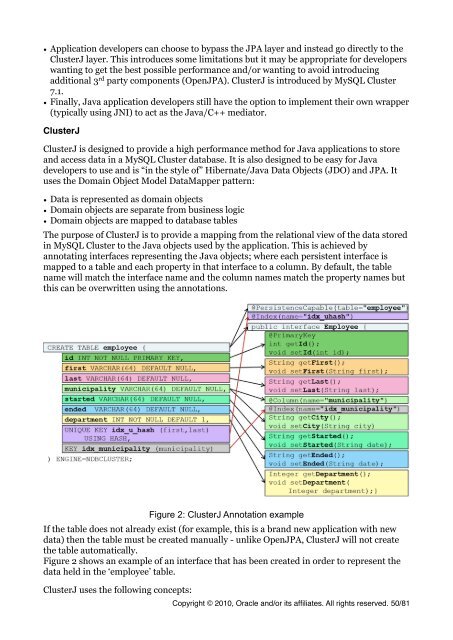MySQL Cluster Tutorial - cdn.oreillystatic.com
MySQL Cluster Tutorial - cdn.oreillystatic.com
MySQL Cluster Tutorial - cdn.oreillystatic.com
You also want an ePaper? Increase the reach of your titles
YUMPU automatically turns print PDFs into web optimized ePapers that Google loves.
• Application developers can choose to bypass the JPA layer and instead go directly to the<br />
<strong>Cluster</strong>J layer. This introduces some limitations but it may be appropriate for developers<br />
wanting to get the best possible performance and/or wanting to avoid introducing<br />
additional 3 rd party <strong>com</strong>ponents (OpenJPA). <strong>Cluster</strong>J is introduced by <strong>MySQL</strong> <strong>Cluster</strong><br />
7.1.<br />
• Finally, Java application developers still have the option to implement their own wrapper<br />
(typically using JNI) to act as the Java/C++ mediator.<br />
<strong>Cluster</strong>J<br />
<strong>Cluster</strong>J is designed to provide a high performance method for Java applications to store<br />
and access data in a <strong>MySQL</strong> <strong>Cluster</strong> database. It is also designed to be easy for Java<br />
developers to use and is “in the style of” Hibernate/Java Data Objects (JDO) and JPA. It<br />
uses the Domain Object Model DataMapper pattern:<br />
• Data is represented as domain objects<br />
• Domain objects are separate from business logic<br />
• Domain objects are mapped to database tables<br />
The purpose of <strong>Cluster</strong>J is to provide a mapping from the relational view of the data stored<br />
in <strong>MySQL</strong> <strong>Cluster</strong> to the Java objects used by the application. This is achieved by<br />
annotating interfaces representing the Java objects; where each persistent interface is<br />
mapped to a table and each property in that interface to a column. By default, the table<br />
name will match the interface name and the column names match the property names but<br />
this can be overwritten using the annotations.<br />
Figure 2: <strong>Cluster</strong>J Annotation example<br />
If the table does not already exist (for example, this is a brand new application with new<br />
data) then the table must be created manually - unlike OpenJPA, <strong>Cluster</strong>J will not create<br />
the table automatically.<br />
Figure 2 shows an example of an interface that has been created in order to represent the<br />
data held in the ‘employee’ table.<br />
<strong>Cluster</strong>J uses the following concepts:<br />
Copyright © 2010, Oracle and/or its affiliates. All rights reserved. 50/81
















